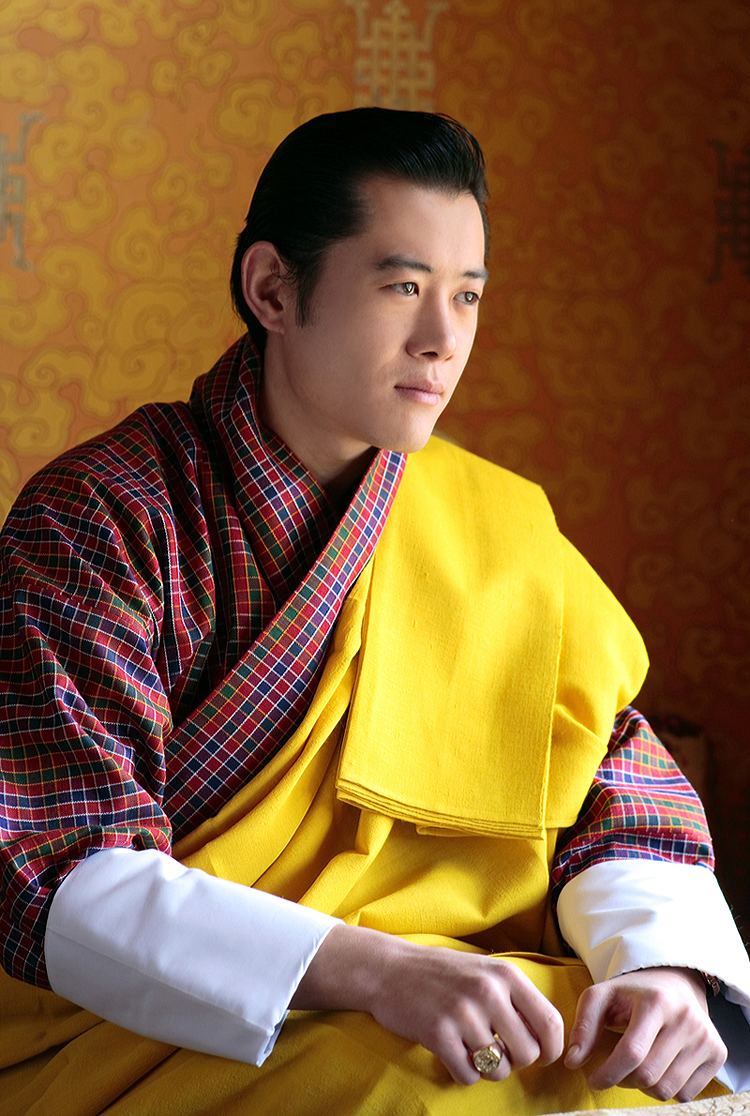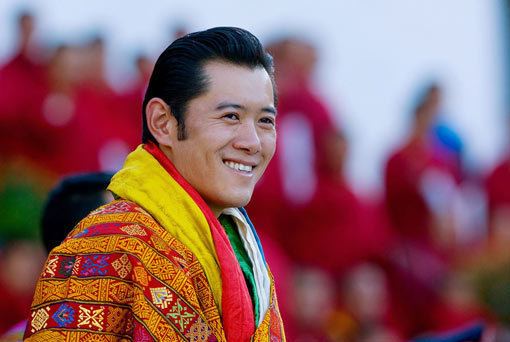Coronation 1 November 2008 Name Jigme Namgyel | House House of Wangchuck Successor Jigyel Ugyen Wangchuck | |
 | ||
Reign 9 December 2006 – present Prime Ministers See listKhandu WangchukKinzang DorjiJigme ThinleyTshering Tobgay Parents Tshering Yangdon, Jigme Singye Wangchuck Education Wheaton College, Phillips Academy, University of Oxford Siblings Dasho Jigme Dorji Wangchuck, Dechen Yangzom Wangchuck Similar People Jetsun Pema, Jigme Singye Wangchuck, Ugyen Wangchuck, Jigme Dorji Wangchuck, Kesang Choden Wangchuck Profiles | ||
Heir presumptive Jigyel Ugyen Wangchuck | ||
Semgawai Lugar (Pemi Tshewang Tashi)
Jigme Khesar Namgyel Wangchuck (འཇིགས་མེད་གེ་སར་རྣམ་རྒྱལ་དབང་ཕྱུག་, Wylie: jigs med ge sar rnam rgyal dbang phyug born 21 February 1980) is the current reigning Druk Gyalpo or "Dragon King" of the Kingdom of Bhutan. After his father Jigme Singye Wangchuck abdicated the throne in his favour, he became King on 9 December 2006. A public coronation ceremony was held on 6 November 2008, an auspicious year that marked 100 years of monarchy in Bhutan.
Contents
- Semgawai Lugar Pemi Tshewang Tashi
- Pm modi meets bhutan s king jigme khesar namgyel wangchuck
- Early life and education
- Crown prince
- Trongsa Penlop
- Ascension to the throne
- Engagement royal wedding and birth of the Crown Prince
- Issue
- Democratisation
- Diplomacy
- Land reform
- Kidu
- DeSuung Training Programme
- Education
- Amnesty
- Public perception and popularity abroad
- Styles
- References

Pm modi meets bhutan s king jigme khesar namgyel wangchuck
Early life and education

Khesar is the eldest son of the fourth Dragon King of Bhutan, Jigme Singye Wangchuck, and his third wife, Queen Tshering Yangdon. He has a younger sister, Princess Dechen Yangzom, and brother, Prince Jigme Dorji, as well as four half-sisters and three half-brothers.

After completing his higher secondary studies at Yangchenphug High School, Bhutan, Khesar studied abroad at Phillips Academy, Cushing Academy and Wheaton College, all in the United States, before graduating from Magdalen College, University of Oxford, where he completed the Foreign Service Programme and International Relations. He also did a course at the Lal Bahadur Shastri National Academy of Administration in Mussoorie, India.
Crown prince

The Crown Prince, popularly known to the people of Bhutan as 'Dasho Khesar', accompanied his father in his many tours throughout the Kingdom to meet and speak to the people. He also officially represented Bhutan on several international events. On 8 May 2002, he represented Bhutan at the 27th UN General Assembly and made his first speech to the United Nations where he addressed issues related to the welfare of millions of children around the globe to world leaders. He attended Thai King Bhumibol Adulyadej's 60th Anniversary Celebrations on 12–13 June 2006 in Bangkok along with royals from 25 countries. The youngest of the visiting royals, the 26-year-old prince caused a sensation, giving rise to a legion of female fans in Thailand. The Thai press dubbed him "Prince Charming," publishing his photograph and running stories about him as well as Bhutan for several weeks after the event.

On 25 June 2002, the Crown Prince was awarded the Red Scarf by his father.
Trongsa Penlop

On 31 October 2004, Khesar was installed as the Trongsa Penlop in Trongsa Dzong. The institution of the Trongsa Penlop, started by Zhabdrung Ngawang Namgyal in 1647, signifies the true heritage to the Bhutanese Throne and the investiture ceremony of the Trongsa Penlop is the formal declaration of this status of the Crown Prince.
Ascension to the throne

In December 2005, the King Jigme Singye Wangchuck announced his intention to abdicate in his son's favour in 2008, and that he would begin handing over responsibility to him immediately. On 9 December 2006, the former King issued a Royal Edict announcing his abdication, and transferred the throne to Jigme Khesar Namgyel Wangchuck, who was officially crowned on 6 November 2008, in Punakha. Religious ceremonies and public celebrations were also held at Tashichho Dzong and Changlimithang Stadium in Thimphu. The coronation ceremony comprised an ancient and colourful ritual, attended by thousands of foreign dignitaries, including the then-President of India, Pratibha Patil.
CNN reported that, to welcome Khesar as King of Bhutan, people painted street signs, hung festive banners and decorated traffic circles with fresh flowers.
His Majesty received (like all the rulers of Bhutan had before him) the white, yellow, red, green, and blue silk scarves.
Engagement, royal wedding, and birth of the Crown Prince
As he opened the session of parliament on Friday, 20 May 2011, the King announced his engagement to Jetsun Pema, born in Thimphu on 4 June 1990. They were married on 13 October 2011 in Punakha Dzong. The royal wedding was Bhutan's largest media event in history. The royal wedding ceremony was held in Punakha followed by formal visits to different parts of the country. During the ceremony the King also received the Crown of the Druk Gyaltsuen (Queen) from the most sacred Machhen temple of the Dzong and bestowed it on Jetsun Pema, formally proclaiming her as Queen of the Kingdom of Bhutan. The wedding was held in traditional style with the "blessings of the guardian deities".
On 11 November 2015, it was announced that the King and Queen of Bhutan were expecting their first child, a son, early in 2016. The king and queen announced, via their Facebook page, the arrival of their son, who was born in Lingkana Palace in the capital city of Thimphu on 5 February 2016.
Issue
Democratisation
The young king began his reign overseeing the democratization of his country by presiding over the last sessions of the parliament where electoral laws, land reform and other important issues were deliberated. He stated that the responsibility of this generation of Bhutanese was to ensure the success of democracy. He traveled extensively to explain and discuss the Draft Constitution of Bhutan with the people, and to encourage participation in the upcoming democratic exercises. He continues such visits, speaking mainly to the youth of Bhutan on the need for Bhutanese to strive for greater standards in education, business, civil service and the need for people of a small country to work harder than those of others.
Diplomacy
The King signed a new treaty of friendship with India in February 2007, replacing the treaty of 1949. Many government initiatives were undertaken by the new King with a view to strengthen the system in preparation for the democratic changes in 2008. The Constitution of Bhutan was adopted on 18 July 2008, by the first elected parliament.
Land reform
The King's first landmark project after his formal coronation was launching the National Cadastral Resurvey in March 2009, aimed at resolving long-standing land issues of excess land that affects every Bhutanese household. A variation of land reform focuses on improving the lives of people living in remote and difficult areas, with the Rehabilitation Project. The pilot Rehabilitation Project at Khinadang in Pemagatshel was initiated in 2011, and inaugurated by Prince Jigme Dorji Wangchuck in October 2014. The Project resettled people living in the more inaccessible areas of the country to the village, and provided them with basic amenities and services, as well as support in agriculture. The project saw tremendous success, and similar projects are in the pipeline in other parts of Bhutan.
Kidu
One of the most important and ongoing works of the King involves Kidu – a tradition based on the rule of a Dharma King whose sacred duty is to care for his people. The people can access Kidu in several ways – by applying to the Office of the Royal Chamberlain, which accepts applications during all working hours; by sending applications through Dzongkhag Kidu Officers in every district, whose responsibility is to collect such applications as well as identify people who need help; and by appealing to the King directly. To give the people the opportunity for direct appeal, the King on his numerous road trips across the country stops for every potential appellant along the road.
There are several Kidu schemes designed to help certain groups of people, such as students unable to afford even the free education available in the country, elderly citizens, those requiring medical treatments. The King has also continued the tradition of giving state land to landless farmers around the country. The ongoing project takes the King to remote villages and communities. An aspect of Kidu includes providing immediate assistance to victims of natural disasters. The King personally supervised the rebuilding efforts following major earthquakes and floods in 2009 and 2011.
In 2012, Nu.100 million from the Armed Forces was granted by the king to the Zhung Dratshang for the Dzong Reconstruction Fund, as on the 24th of June, the historic Wangduephodrang Dzong was destroyed by fire. As Supreme Commander of the Armed Forces, the King commanded the armed forces and De-suups to the site immediately, and with help from dzongkhag officials and citizens, many things were saved from the fire. The King himself rushed to the scene within hours.
DeSuung Training Programme
The King initiated a military-style training for volunteers known as the DeSuung Training Programme in 2011, on the request of the youth. The programme is aimed to equip volunteers with the skill to provide assistance during emergencies, and has been hugely successful, with over 3000 volunteers having completed their training, and volunteering for numerous public events and emergencies.
Education
The King has stressed the importance of education in almost all his public addresses, and makes it a point to visit schools at every opportunity. In line with this, he grants scholarships to students from different parts of the country. The recipients of His Majesty’s Scholarship Kidu go to various colleges and schools in Bhutan, India, Thailand, The Philippines, Singapore, Japan and Europe. Several scholarships, like the Trongsa Penlop Scholarship, have been offered by universities abroad to His Majesty as a gesture of goodwill, and appreciation of, His Majesty The King.
Amnesty
The Constitution of Bhutan empowers the King to grant amnesty to prisoners. In 2014, he pardoned 45 prisoners who had been imprisoned for possessing an excessive amount of tobacco, following an amendment of the Tobacco Control Act of Bhutan 2010 by the Parliament of Bhutan, since the amended law could not be enforced retroactively, and previous offenders who would not be liable now would still be tried under previous laws. The Royal Pardon was granted to those who were not repeat offenders and who had good prison records. The prisoners still had to pay a fine as the tobacco law had changed.
Public perception and popularity abroad
The "People's King", like his father, enjoys exceptionally warm relations with India. He has visited India on several occasions, and was invited as the Chief Guest for India's 64th Republic Day celebrations in 2013.
Following his 2006 visit to Thailand as Crown Prince, the King has been immensely popular in Thailand. The number of Thai tourists visiting Bhutan has increased steadily since the visit.
In November 2011, the King with Queen Jetsun made a state visit to Japan; they were the first state guests to Japan since the 2011 earthquake. The Royal Visit had a similar effect, with reports that the Japanese were infatuated with the King and country.
In March 2015, the King and Queen were among the foreign dignitaries who attended the funeral of Singapore's former Prime Minister Lee Kuan Yew.
